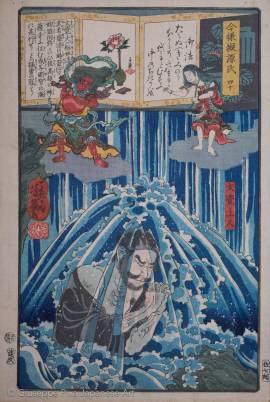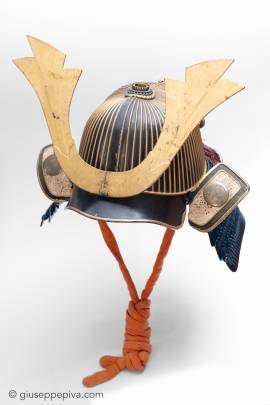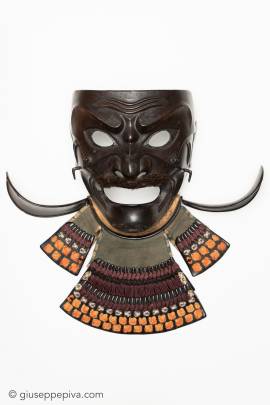Utagawa Yoshiiku (1833 –1904)Print with Mongaku under the waterfall Date: 1864Series: "Imayo Nazorae Genji" Modern comparison for the Tale of Genji; chapter 40Signature: Chokaro Yoshiiku gaPublisher: OmiyaFormat oban, 24.5 x 37 cmThe print depicts the monk Mongaku Shonin in repentance beneath a waterfall. The scene is based on the legend of Endo Morito, the secular name of Mongaku who was originally a samurai a samurai guard of the imperial family in Kyoto. In his late teenage years, he fell in love with Kesa, the beautiful wife of his samurai...
WORKS FOR SALE
62-plate samurai helmetHaruta school, Edo period17th-18th century A lamellar helmet consisting of sixty-two plates joined with five rows of rivets. The surface is lacquered with black urushi, while the sujitate, the folded parts of each lamella, are lacquered in gold.This color contrast is reminiscent of the akoda-nari type helmets produced by the Haruta school since the Kamakura period. The sinuous curves of all parts of the helmet are also typical of the production of this school, which remained active until the Edo period. Both the swelled tenkokuzan shape of the bowl, and the...
A full-face russet iron samurai amour’s mask with fierce expressionEarly Edo period, 17th -18th centuryProvenance:Kyoto, Arashiyama MuseumLiterature:Kyoto Arashiyama Bijutsukan, catalog, pag. 28Iida Kazuo, Katchû-men (Tokyo, 1991), cat. 123Rare lacquered iron sōmen lacquered in kuro-urushi. The mask, with an expression both strong and elegant, is constructed in two parts only, with the nose incorporated into the upper section. This type of fabrication is found in some sōmen signed by Wushu Masanobu, of which other features, such as the shape of the side wrinkles and the protuberance...
Copyright © 2016 - giuseppe piva - VAT: 05104180962










